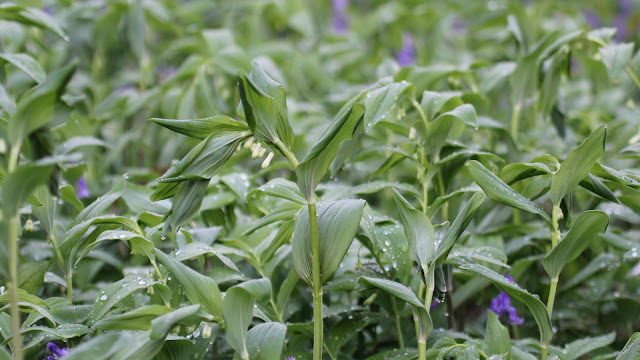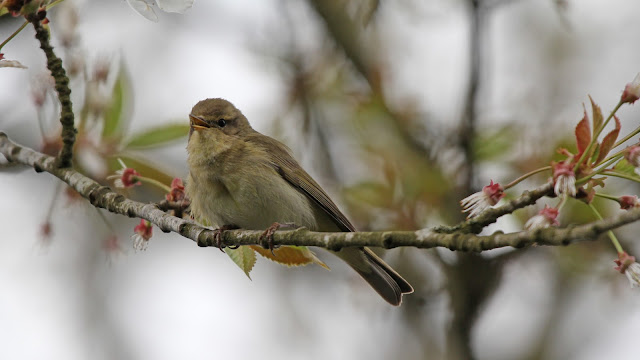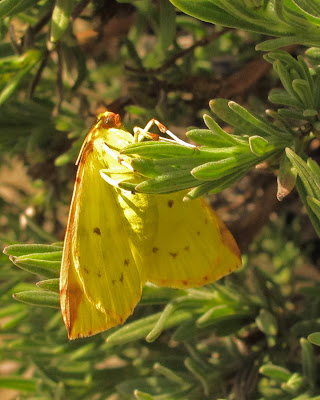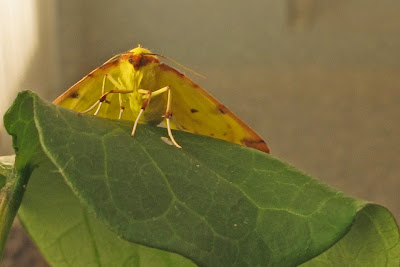For a change the morning was clear with sunshine and a little mist. The previous days have seen heavy rain, and it has been impossible to get out. This morning I took the chance very early on to walk around Old Down Wood to see what was around, and what had changed.
The first thing I noticed was how wet and muddy the tracks and footpaths were, water was lying everywhere, a symptom unfortunately of the clay and chalky soil. This time of year the water doesn't soak in and usually just evaporates in the wind and sun. I walked around the north perimeter, the bluebells still have some more time required to peak, but the floor of the wood is now very green, with the Bluebell leaves, the Dog Mercury, Ramsoms and now Solomon's Seal. The Dog Mercury as I mentioned in a previous post has very inconspicuous flowers, and the sexes are separate plants so large patches can be either male or female, and they are then dependent mostly on insect pollination.
The Solomon's Seal have only recently started to emerge, being seen mostly on the northern perimeter edge. These are plants that have leaves arranged alternatively in two rows on either side of the stem. Hanging underneath them are small white and green tipped flowers, that look like bells. The flowers are not that advanced yet, but there are few that can be seen at the moment. The recent rain has left them looking a bit bedraggled though.
At the West End, I found a pair of Marsh Tits. They originally flew past me and into the undergrowth, but I was able to get them to respond to the tape. This one was extremely vocal in response, although it wouldn't come to close, preferring to scold me from a distance. this was the first time I had found Marsh Tits in this part of the wood. Unfortunately again today there was no sign of the Willow Tits.
The bluebells continue to hold a spell, and again I couldn't resist another opportunity to build up a picture. The rain drops and watery sunshine helped once again.
I walked out towards the Gradwell entrance, and then back along the southern perimeter. Blackcaps had definitely increased, today I counted at least 5 singing males, and I saw 3 females. Every song seemed different, and warranted a close listen, just in case it could be Garden Warbler, but I was happy they were all Blackcaps.
The Tawny Owl was in it's usual tree, and also had neighbours in a pair of Bullfinches. The Bullfinches seemed to be totally unaware of the owl, and the owl was not concerned by either them or me, so I left it in peace to enjoy the sunshine while it could.
At the Kitwood footpath entrance I heard a Willow Warbler singing, my first for a couple of weeks. I wasn't able to see it though as it was well hidden in the now well advanced leaves of the larch trees. I walked around the perimeter to the main path then headed back to the cross roads, and out towards the Brislands entrance. A Song Thrush was in full song in an oak tree, and probably has a mate nearby sitting on eggs. I saw one earlier foraging on the leaf litter in the same location.
As I approached the style I noticed a small bird in the trees, the first good view was unhelpful, as it had it's back to me, and it's feathers all fluffed out. Any ideas?
After a while I managed to get a better view, and it also decided to sing, which clinched the identification...
Apologies for more pictures of a Chiffchaff, and there is a good chance I have photographed this one before based on where I found it, but very soon all the leaves will be out, and all I will be able to get will be the song, and I think these little birds are gorgeous, and much better than their monotonous song.
With week being so wet and miserable there has been little else to report, however on Monday as I came home I noticed a yellow butterfly on the lawn, and as it setlled I managed to catch it and take it indoors. It was in fact a moth, a Brimstone Moth. I know these are considered quite common, but I don't get the chance to see moths that often let alone photograph them, so this was an nice opportunity.
The markings are beautiful, as are the soft hairs on the thorax and head. It usually flies after dusk, but can be seen by day, and is mistaken for a butterfly
I would love to have a moth trap in the garden, but don't have the time in the morning when I work to empty it, so I shall have to wait, but it is definitely something for the future












No comments:
Post a Comment
Note: only a member of this blog may post a comment.